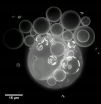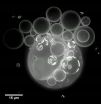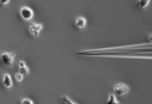(Press-News.org) VIDEO:
A collection of artificial lipid bubbles cycle through changes in their membranes as the surrounding environment changes. As the osmotic potential changes, different lipids in the membranes form patchy domains...
Click here for more information.
Tiny, soapy bubbles can reorganize their membranes to let material flow in and out in response to the surrounding environment, according to new work carried out in an international collaboration by biomedical engineers at the University of California, Davis, and Nanyang Technological University in Singapore. This behavior could be exploited in creating microbubbles that deliver drugs or other payloads inside the body — and could help us understand how the very first living cells on Earth might have survived billions of years ago.
The study, led by Atul Parikh, professor of biomedical engineering, and chemical engineering and materials science, was published Oct. 15 in the journal eLife.
Lipid vesicles are closed compartments within cells that isolate material dissolved in water from the rest of the cell. Most structures inside cells are surrounded by such a lipid membrane, as is the cell itself. Water can cross the membrane surrounding the vesicle, but dissolved material, such as salts, sugars or proteins, cannot. That means that when there is a higher concentration of dissolved material on one side of the membrane than the other, water will move by osmosis across the membrane to dilute it.
Place a vesicle in a solution that is weaker than its contents, and it will swell as water moves in; reverse the situation and the vesicle shrivels up. Eventually, swelling vesicles will burst.
Modern living cells have evolved complexes of proteins that can pump excess water or salts in and out of cells. But how did the very first cells cope with this problem?
Parikh and colleagues worked with artificial vesicles with membranes composed of a mixture of lipids that can either form a uniform mixture or, in the right circumstances, self-organize into distinct domains within the membrane. They used fluorescent dyes and a specialized microscope to watch the vesicles as they were subjected to different conditions.
When the solution outside was equivalent to the inside of the vesicle, the membranes were flaccid and evenly mixed. When they diluted the concentration of the solution outside, the vesicles swelled up as expected, but the membranes spontaneously organized into patchy domains. These domains grew and then dispersed in a remarkably cyclical way. As the domains grew, pores briefly formed in the membrane releasing some of the contents, then sealed up again.
In effect, these vesicles — made only of water, lipids and salts — are able to display a complicated behavior that lets them sense and react to their environment, the authors write.
Billions of years ago, such emergent behavior could have allowed the earliest living cells to adapt to changing environmental conditions. Today, it could be a factor helping to regulate vesicles inside modern living cells, or could help in designing synthetic vesicles and model protocells that might carry drugs to specific locations in the body, for example to treat tumors. It could also offer ways to tap chemical energy, stored as a concentration gradient, to drive reorganization of structures in membranes.
INFORMATION:
Co-authors on the study were Kamila Oglęcka, Bo Liedberg and Rachel Kraut, Nanyang Technological University, Singapore; and Padmini Rangamani, UC Berkeley. The work was funded by the U.S. Department of Energy and the Singapore Ministry of Education.
Emergent behavior lets bubbles 'sense' environment
2014-10-27
ELSE PRESS RELEASES FROM THIS DATE:
One drop will do: UBC researchers develop simple new test for vitamin B12 deficiency
2014-10-27
Researchers at the University of British Columbia have developed a novel method to test for vitamin B12 deficiency that is sensitive enough to work on anyone, including newborn babies and large swaths of the general population.
Vitamin B12 deficiency can be tested with a single drop of blood collected from a finger prick, then blotted and dried overnight on a card consisting of filter paper. The UBC study made dried blood spot card analysis sensitive enough to measure the amount of methylmalonic acid (MMA), an indicator of a person's B12 level.
"This minimally invasive ...
International research group publishes updated criteria for diagnosing multiple myeloma
2014-10-27
ROCHESTER, Minn. –The International Myeloma Working Group (IMWG) today announced that it has updated the criteria for diagnosing multiple myeloma. A paper outlining the new criteria was published in the journal Lancet Oncology. Multiple myeloma is a blood cancer that forms in a type of white blood cell called a plasma cell.
"Our group, which includes more than 180 myeloma researchers worldwide, has updated the definition of multiple myeloma for diagnostic purposes to include validated biomarkers in addition to the current clinical symptoms used for diagnosis which ...
Diabetes patients report better outcomes with improved physician accessibility
2014-10-27
LOS ANGELES — A new model of delivering primary care studied by Keck Medicine of the University of Southern California (USC) researchers has the potential to improve the health of patients with type 2 diabetes.
The model encourages doctors to be more of a "medical home" for their patients by being accessible to patients in person and by phone, developing good ongoing relationships with their patients, and being more proactive in helping coordinate care for patients with difficult health problems.
Gregory Stevens, Ph.D., associate professor of family medicine ...
Clinical results indicate vaccine candidate highly efficacious against bacterial diarrhea
2014-10-27
Washington, DC, October 27, 2014—New results from a safety and immunogenicity study, which included a challenge phase to test efficacy, indicate that a live attenuated enterotoxigenic Escherichia coli (ETEC) vaccine candidate, given in combination with a novel adjuvant, provided significant protection against disease. This represents the first efficacy data for this vaccine/adjuvant combination, which was 58.5 percent efficacious in protecting against diarrhea of any severity using a highly rigorous ETEC human challenge model. The vaccine/adjuvant combination was ...
How cells know which way to go
2014-10-27
VIDEO:
In this video, lab-grown human leukemia cells move toward a pipette tip holding an attractive chemical.
Click here for more information.
Amoebas aren't the only cells that crawl: Movement is crucial to development, wound healing and immune response in animals, not to mention cancer metastasis. In two new studies from Johns Hopkins, researchers answer long-standing questions about how complex cells sense the chemical trails that show them where to go — and the ...
The Ebola epidemic: Is there a way out?
2014-10-27
Berlin, 27 October 2014. Not everyone who contracts the Ebola virus dies, the survival rate is around 30% suggesting that some kind of immunity to the disease is possible. Experimental treatments and vaccines against Ebola exist but have not yet been tested in large groups for safety and efficacy (phase 2 trials).
The International Union of Immunology Societies (IUIS) published a statement today in its official journal, Frontiers in Immunology calling for urgent and adequate funding of vaccine candidates in clinical trials and speedy implementation of immunisation in ...
Chest radiation to treat childhood cancer increases patients' risk of breast cancer
2014-10-27
A new study has found that patients who received chest radiation for Wilms tumor, a rare childhood cancer, face an increased risk of developing breast cancer later in life due to their radiation exposure. Published early online in CANCER, a peer-reviewed journal of the American Cancer Society, the findings suggest that cancer screening guidelines might be re-evaluated to facilitate the early diagnosis and prompt treatment of breast cancer among Wilms tumor survivors.
Wilms tumor is a rare childhood kidney cancer that can spread to the lungs. When this spread occurs, patients ...
Latest bone research abstracts summarized in slides and videos
2014-10-27
Today, the International Osteoporosis Foundation (IOF) has published an educational slide deck highlighting 60 original scientific abstracts presented at the Annual Meeting of the American Society for Bone and Mineral Research (ASBMR) in September 2014.
The succinct slide kit can be downloaded free of charge by all individual IOF members (free sign up on the IOF website).
CEO Judy Stenmark stated, "IOF is pleased to provide this informative resource for healthcare professionals interested in the latest advances in bone and mineral research. While 10% of the featured ...
It's better for memory to make mistakes while learning
2014-10-27
Toronto, Canada – Making mistakes while learning can benefit memory and lead to the correct answer, but only if the guesses are close-but-no-cigar, according to new research findings from Baycrest Health Sciences.
"Making random guesses does not appear to benefit later memory for the right answer , but near-miss guesses act as stepping stones for retrieval of the correct information – and this benefit is seen in younger and older adults," says lead investigator Andrée-Ann Cyr, a graduate student with Baycrest's Rotman Research Institute and the Department ...
Study shows ethnic groups are at higher risk for heart disease yet many aren't aware
2014-10-27
VANCOUVER ─ Different ethnic groups have widely varying differences in both the prevalence and awareness of cardiovascular risk factors, a finding that highlights the need for specially designed education and intervention programs, according to a study presented today at the 2014 Canadian Cardiovascular Congress.
The conclusion comes from a study of more than 3,000 patients at an urgent-care clinic serving an ethnically diverse area of Toronto. Participants were asked to self-identify their ethnicity and, from a list of 20 activities or conditions, asked to identify ...


